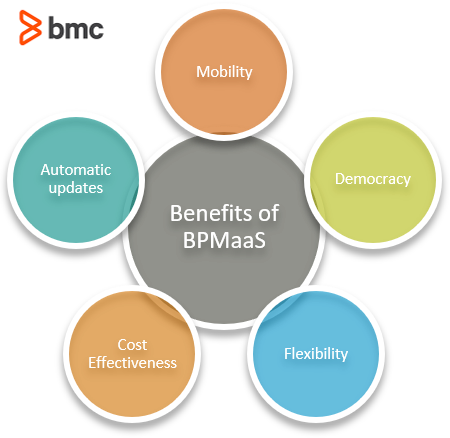It is a no brainer that the cloud has significantly changed the way IT services are delivered around the world. The benefits of cost effectiveness, speed of deployment and scalability, as well as superior support from cloud providers far outweigh the risks of security and loss of control. Digital transformation has seen organizations choosing to migrate their workloads to the cloud.
Business process management hasn’t been left behind, and the cloud has led to a new BPM domain i.e. BPM as a Service (BPMaaS). Technavio estimates that the BPMaaS sector will grow more than $24 billion USD over the next five years, progressing at a CAGR over 31%.
It’s safe to say that the combination of cloud and BPM looks a sure bet in the future. Let’s look at BPMaaS.
What is BPMaaS?
BPMaaS draws on business process management, the method organizations use to manage and improve their processes. (Processes are different from practices.) BPM is all about fine-tuning processes to squeeze out every possible drop of optimization. BPMaaS builds on this. CloudSocket says:
BPMaaS is an internet-based service that offers a dedicated business process in a cloud-based manner.
Residing somewhere between SaaS and PaaS, it essentially provides a fixed software service, but also offers hooks for introducing your own logic.

BPMaaS packages process design, implementation, and optimization capabilities in a subscription-based cloud service. In the book Enterprise Cloud Computing: A Strategy Guide for Business and Technology Leaders, authors Andy Mulholland, Jon Pyke, and Peter Fingar describe how BPMaaS covers the full lifecycle of business processes, from conception, design implementation, and optimization, all coupled with a robust workflow engine.
BPMaaS will cost effectively and quickly map and deploy your processes through a cloud service that provides a scalable price based on:
- Metrics such as number of users, processes, and interfaces
- Support services
Other terms used to describe this domain include:
- Business Process as a Service (BPaaS). Defined by Gartner as the delivery of business process outsourcing (BPO) services that are sourced from the cloud and constructed for multitenancy. Pricing models are consumption-based or subscription-based commercial terms, with services often automated.
- Cloud-enabled BPM. According to IOPscience, this consists of business processes, business information, and IT resources, which help build real-time intelligence systems based on business management and cloud technology.
Who uses BPMaaS?
Any organization wanting to establish its business processes can take advantage of BPMaaS.
BPMaaS also facilitates digital transformation for organizations who want to manage their business processes through the cloud. Integration with AI, robotic process automation (RPA), and Big Data solutions allow companies to take their processes to the next level by:
- Facilitating intelligent decision making through predictive analytics.
- Driving efficiency through automation.
For industry sectors like financial services and manufacturing involved in global distributed operations, BPMaaS provides valuable capabilities such as:
- Real time process optimization
- Scaling self-service capabilities through mobile and web apps
Benefits of BPMaaS
Forbes says the anything as a service model is becoming a mindset, just as it is a strategy, on account of being fueled by digital transformation. We can map the as a service advantages to BPMaaS as follows:

Mobility
This year, almost every organization around the world has realized the value of mobility. Using BPMaaS solutions means that employees and stakeholders in different locations can participate in developing and executing business processes through cloud-based platforms.
Two main benefits of mobility for BPMaaS include:
- Collaboration during process development
- Ease of decision making for required changes to process artifacts.
Democracy
BPMaaS solutions level the field for developing, operating, and optimizing processes. That means that anyone from a startup to a corporation, small business to government agency, can take advantage given that the service suite is open and scalable.
This is driven by low-code and no-code solutions, which employ easy to use, drag-and-drop capabilities to design forms, workflows, and reports required to support business processes.
Flexibility
The constraints of legacy systems required significant effort and time to process any changes. BPMaaS solutions facilitate agility and flexibility through simplified architecture that facilitates integration. This means companies can take advantage and make changes to their processes on the fly—you’re no longer bound to legacy workflows.
This is especially invaluable in situations where customer demand or regulation changes are frequent and unpredictable. For example, using BPMaaS solutions instead of legacy systems means you can quickly make changes to:
- A business form to incorporate a legal requirement
- A workflow to support a premium customer with new requirements
- Any number of other changes
Cost effectiveness
BPMaaS solutions employ subscription-based billing. For small businesses, taking up these solutions means:
- No upfront capital costs
- Scaling on need basis
Organizations can prioritize which processes to be managed on the cloud, and then calculate the most effective cost model to deploy. When considering TCO and costs related to security and compliance, small and medium businesses will definitely find better value investing in BPMaaS.
Updates
As with any other cloud-based offering, most BPMaaS solutions will be automatically updated. Users will have access to the latest features and relevant security updates.
This is especially important for business process management, where organizations want to be sure that the hosting environment for their processes will remain relevant, even as their processes evolve.
BPMaaS for continuous improvement
The business process management practice is all about making the most from a situation while continuously looking for areas to improve. BPMaaS can help you understand your true potential—and where you are currently. Like any tool, however, true progress will come only with the right people in place.
Additional resources
For related reading, explore these resources:
- BMC Multi-Cloud Blog
- BMC Business of IT Blog
- Intelligent Business Process Management Suites (iBPMS): The Basics
- Digital Transformation Trends for 2021
- Public vs Private vs Hybrid: Cloud Differences Explained
These postings are my own and do not necessarily represent BMC's position, strategies, or opinion.
See an error or have a suggestion? Please let us know by emailing blogs@bmc.com.





